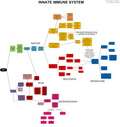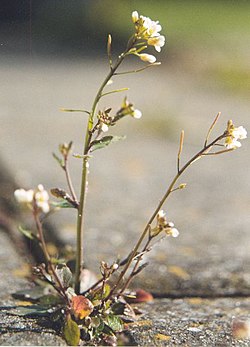In plant immunology, the hypersensitive response (HR) is a mechanism used by plants to prevent the spread of infection by microbial pathogens. HR is characterized...
33 KB (3,954 words) - 05:22, 1 June 2025
classification of the different types of hypersensitivity based on the types of antigens and immune responses involved. According to this system, known...
21 KB (1,860 words) - 20:23, 1 June 2025
Type IV hypersensitivity, in the Gell and Coombs classification of allergic reactions, often called delayed-type hypersensitivity, is a type of hypersensitivity...
7 KB (508 words) - 10:59, 15 March 2024
Hypersensitivity (also called hypersensitivity reaction or intolerance) is an undesirable and adverse immune response to an antigen. Hypersensitivity...
1,018 bytes (133 words) - 11:47, 5 March 2025
Type III hypersensitivity, in the Gell and Coombs classification of allergic reactions, occurs when there is accumulation of immune complexes (antigen-antibody...
12 KB (1,155 words) - 14:05, 24 May 2025
Inflammation (redirect from Inflammatory response)
irritation. A common example is hay fever, which is caused by a hypersensitive response by mast cells to allergens. Pre-sensitised mast cells respond by...
96 KB (9,751 words) - 00:12, 3 June 2025
Innate immune system (redirect from Innate immune response)
triggered by specific elicitors, the plant produces a localized hypersensitive response (HR), in which cells at the site of infection undergo rapid apoptosis...
44 KB (4,847 words) - 22:06, 25 May 2025
between a normal infectious immune response and a type 1 hypersensitivity response is that in type 1 hypersensitivity, the antibody is IgE instead of IgA...
9 KB (840 words) - 13:07, 15 March 2024
cells. In pathogen interactions, the common short-term response is the hypersensitive response, in which cells surrounding the site of infection are signaled...
16 KB (1,771 words) - 10:26, 19 April 2025
recognition and activation of defense signaling networks leading to the hypersensitive response, which is one of the mechanisms of the resistance of plants to...
18 KB (1,971 words) - 00:26, 26 May 2025
Immunotoxicology (section Hypersensitivity)
or environmental setting. Agents that are known for creating a hypersensitive response include poison ivy, fragrances, cosmetics, metals, preservatives...
9 KB (1,061 words) - 12:10, 9 December 2024
often results in a form of programmed cell death (PCD), called hypersensitive response (HR). Pathogens can then evolve and develop new effectors for overcoming...
8 KB (910 words) - 04:06, 1 June 2025
and basophils are the effector cells involved in the immediate hypersensitivity response. Found in tissues throughout the body, they are particularly associated...
5 KB (470 words) - 22:25, 23 May 2025
T helper cell (redirect from Th1 response)
to, a hypersensitivity response occurs. Hypersensitivity is believed to be the cause of allergy and some auto-immune disease. Hypersensitivity reactions...
54 KB (6,618 words) - 15:58, 30 April 2025
Sw-5 gene gives resistance to the TSWV through a hypersensitive response. A hypersensitive response is when the plant cells that surround the infection...
13 KB (1,505 words) - 00:28, 19 March 2025
cell's immune response, pathogens frequently target the chloroplast. Plants have two main immune responses—the hypersensitive response, in which infected...
193 KB (19,591 words) - 04:33, 2 June 2025
a pathogen attacks. An oxidative burst causes hypersensitive cell death called a hypersensitive response (HR). This soft rot can trigger HR to assist in...
25 KB (2,872 words) - 10:33, 10 May 2025
exposed plant cells. Hydrogen peroxide exposure may also result in hypersensitive response, which is the death of a small number of host cells at the site...
22 KB (2,555 words) - 10:14, 5 November 2023
hairless Haemodynamic response, delivery of blood to tissues Heart rate Homologous recombination, in genetics Hypersensitive response, of plants to infection...
3 KB (377 words) - 17:40, 17 May 2025
Immune system (redirect from Host response)
part of a plant becomes infected, the plant produces a localized hypersensitive response, whereby cells at the site of infection undergo rapid apoptosis...
119 KB (13,520 words) - 23:00, 22 May 2025
meaning that they can be detected by the plant and lead to a hypersensitive response which restricts the growth of the pathogen. P. infestans was found...
76 KB (7,981 words) - 09:26, 29 May 2025
proteins plant ferredoxin-like amphipathic protein (pflp) and hypersensitive response-assisting protein (hrap) were isolated from sweet pepper and introduced...
18 KB (2,054 words) - 18:52, 5 April 2025
An allergic response is a hypersensitive immune reaction to a substance that normally is harmless or would not cause an immune response in everyone. An...
3 KB (436 words) - 04:04, 25 July 2024
Dentin hypersensitivity (DH, DHS) is dental pain which is sharp in character and of short duration, arising from exposed dentin surfaces in response to stimuli...
26 KB (3,177 words) - 15:09, 9 April 2025
Recognition of a pathogen effector leads to a dramatic immune response known as the hypersensitive response, in which the infected plant cells undergo cell death...
79 KB (8,708 words) - 03:23, 1 June 2025
as chitinases, beta-glucanases, or peroxidases Hypersensitive response – a rapid host cell death response associated with defence induction. The plant immune...
66 KB (7,550 words) - 22:49, 1 June 2025
Cell-mediated immunity (redirect from Hypersensitivity, delayed)
Cellular immunity, also known as cell-mediated immunity, is an immune response that does not rely on the production of antibodies. Rather, cell-mediated...
14 KB (1,377 words) - 23:44, 25 May 2025
antimicrobial agents in the immune response. Reactive oxygen species also play an important role in the hypersensitive response of plants against pathogen attack...
11 KB (1,287 words) - 00:41, 7 June 2024
plant-bacteria relationship are the avirulence (avr) genes, the hypersensitivity response and pathogenicity (hrp) genes, and the pathogenicity factors (rpf)...
17 KB (1,841 words) - 12:56, 23 May 2025
via the Hrp secretion system (IIISP; TC# 3.A.6) and elicits a hypersensitive response (HR) in non-host plants upon infection and pathogenicity in hosts...
4 KB (502 words) - 18:22, 8 September 2022




















